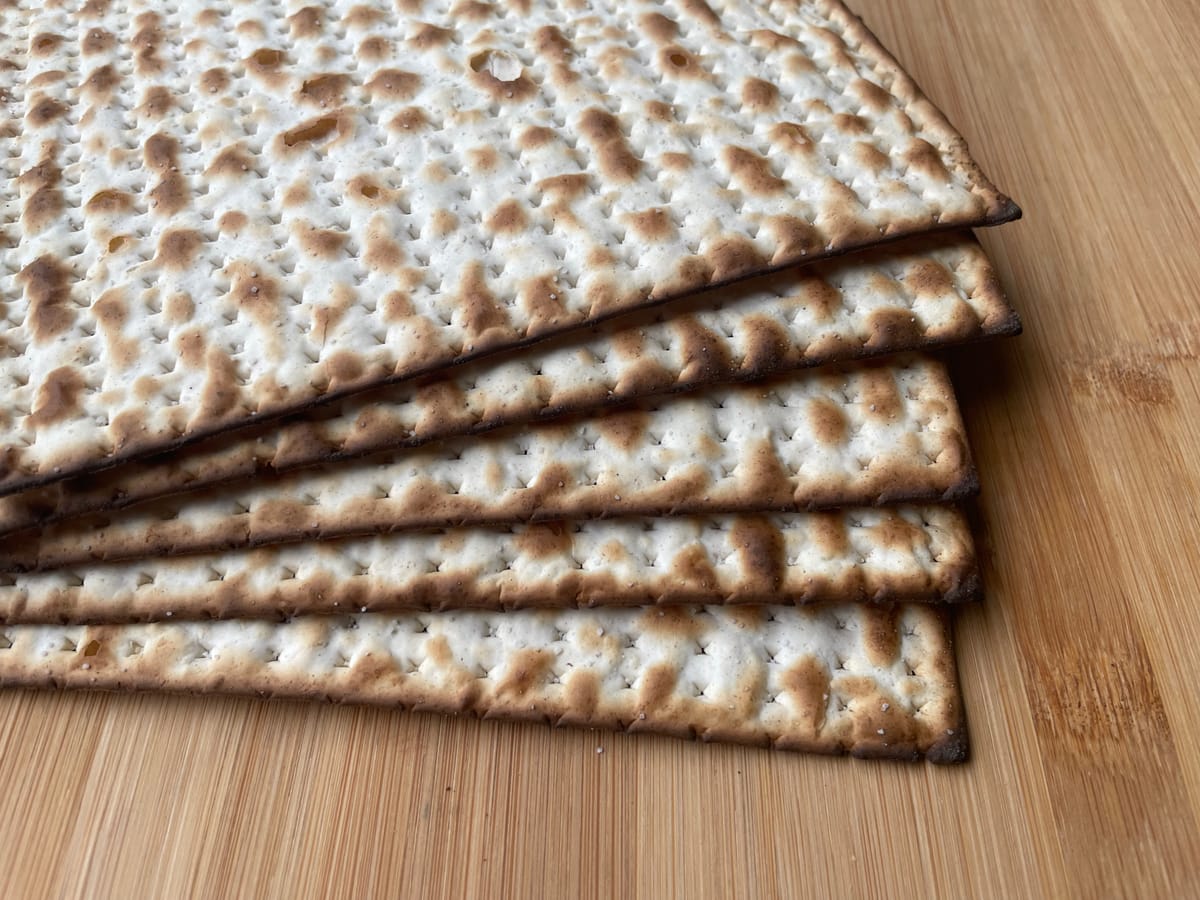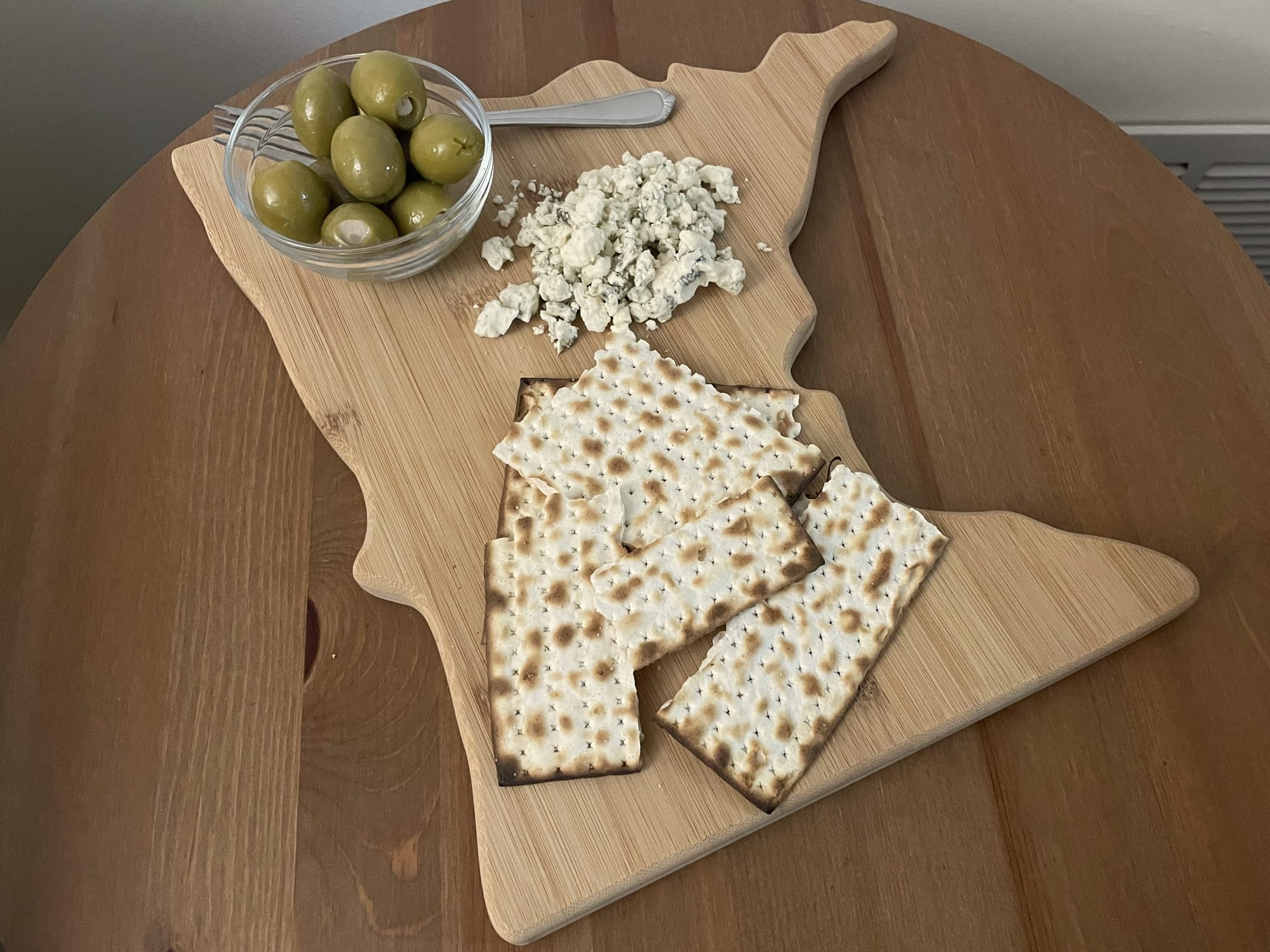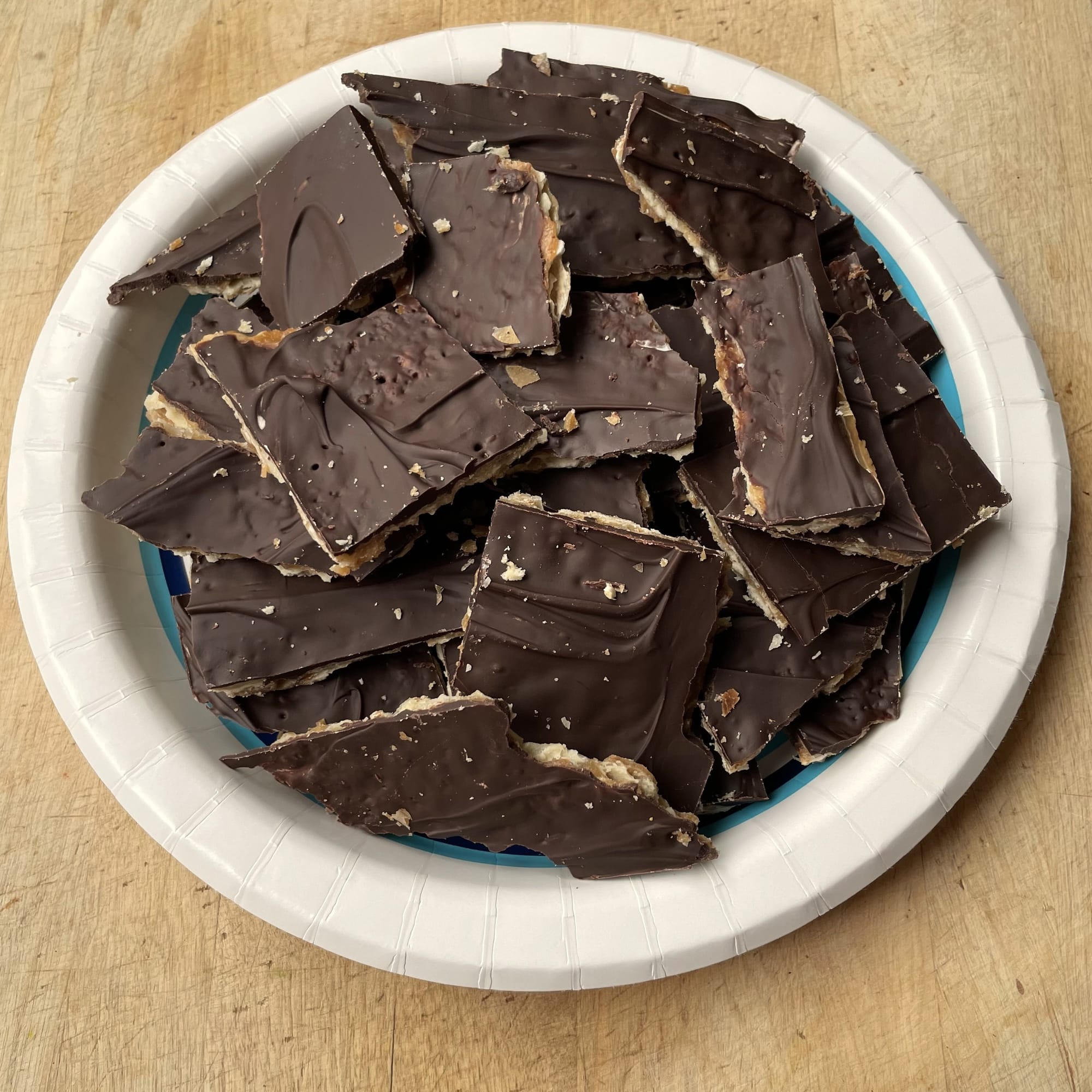8 Days of Matzah

Why I didn't keep kosher for Passover, but ate lots of matzah anyway
Even if you're not Jewish, you've probably noticed the "kosher for Passover" labels on certain processed foods. During the spring holiday of Passover (seven days in Israel, eight days in the diaspora) many Jews abstain from eating or coming into contact with grain products that have risen or fermented. The forbidden grain-containing foods and beverages (collectively known as hametz) must be discarded or sold, and kitchens, cooking utensils, and dishes must be deep-cleaned to ensure that every speck of not-kosher-for-Passover food has been eliminated. The only grain-based product that is kosher for Passover is matzah, an unleavened, cracker-like bread produced in an extremely specific way under rabbinic supervision.
I don't keep kosher for Passover—it's not a requirement of Humanistic Judaism (the denomination I belong to), and I know from my experience as a Catholic that dietary restrictions aren't a religious practice I find spiritually meaningful. However, in the lead up to Passover, the kosher-for-Passover dessert recipes and tips for making the best matzah lasagna in my social media feed and email inbox made me feel like I was missing out on something. Even if dietary restrictions aren't spiritually resonant, they provide a sense of community, a "we're all in this together" feeling as you settle for a matzah spread with pizza sauce and sprinkled with mozzarella in lieu of a slice of pizza. I wasn't up for ritually cleansing my home of hametz and giving up eating oatmeal for breakfast, but I wanted to do something to celebrate Passover beyond simply showing up at my synagogue's Passover Seder.
I found inspiration in a recent Passover-themed episode of Judaism Unbound, a podcast that advocates for a flexible, creative approach to Judaism. One of the hosts, Lex Rofeberg, talked about how he makes sure to eat matzah every day of Passover. He finds it more meaningful to do something additive to celebrate his Jewishness, rather than stressing out about what surfaces his food might have touched. Eating matzah every day is a way to continuously celebrate Passover, versus limiting the celebration to the Seder. He explained, "To me, it's better to eat a little bit of matzah [every day] and break all the rules—let's say somebody ate ham and bread for all of their meals during Passover, but they had matzah every day—I actually think that there's something about that that I would like."
That approach (eating matzah every day, not necessarily the bread and ham part) made a lot of sense to me: doing something extra, eating something specifically Jewish, felt more meaningful that omitting wheat, barley, oats, spelt, and rye from my diet (plus rice, millet, corn, and legumes, depending on what denomination you follow and/or whether or not you're Ashkenazi. Like so many things about Judaism, it's complicated.) So I bought a box of matzah from my local grocery store, ignoring the "Not Kosher for Passover" label on the front, and I resolved to eat matzah each day of Passover.
Day 1
Jewish holidays start at sundown, rather than midnight, so at 7:51 p.m. (18 minutes before sunset) I lit four Passover candles and said a Humanistic Jewish blessing. A few minutes after Passover officially began around at 8:09, I ate my first-ever piece of matzah—it tasted like an extra-crispy saltine.
There are lots of Jewish foods that I had eaten before converting: challah, bagels, matzo ball soup, knishes, bialys, latkes. Eating matzah for the first time explicitly for Passover felt significant and like I was the right track with my matzah-a-day practice.
In lieu of attending a seder (my synagogue always schedules our community seder on a Saturday), I decided to double up on matzah in honor of the first day of Passover by making matzah brei for dinner the following evening. I used a recipe from The Nosher, leaving out the jam to make it more savory and dinner-friendly. I enjoyed it—eggs scrambled with pieces of matzah seems like an odd concept but texturally, it really works.
Day 2
I had to taste some olive oil for an article that I'm writing, so I used matzah as a palate cleanser between oils.
At my synagogue's new member social, one of the attendees mentioned that she never belonged to a formal Jewish community when she lived in NYC because Judaism was so intertwined into the culture—she could live out her Jewishness simply by existing. In Minnesota, she felt like she had to be more intentional about being Jewish, because we're such a minority. It's especially noticeable at holidays: Christian or not, you can't not realize that Christmas is happening. But Passover? Other than the seder dinner on my schedule for this weekend, my daily dose of matzah is the only thing in my offline life that connects me to the holiday.
Day 3
I might be a food writer, but that doesn't mean every day is culinary triumph—today I ate a half sheet of matzah over the sink.

Day 4
I stepped things up after yesterday's sad matzah snack with a matzah board for Friday date night at home: matzah, blue cheese, and olives, which we enjoyed while sipping gin.
I also made a six-stranded challah for Shabbat—if I'm not keeping kosher for Passover, why not go all in. Baking challah is one of the things that reliably gives me a sense of joyful connection to Judaism. To me, it makes more sense to supplement my challah baking with matzah eating, versus substituting one form of connection for another.
Day 5
So. Much. Matzah.
Today was my synagogue's community Passover Seder (at a UU church, since we don't have our own space—my post-Catholic religious journey has come full circle). I volunteered to do a reading and bring a dessert, using this as a convenient excuse to make a batch of matzah toffee. I adapted my saltine toffee recipe, and obviously had to do some taste testing—the salty/sweet matzah, toffee, and chocolate combination is amazing.

During the seder itself, there was plenty of ceremonial matzah eating: matzah with maror (bitter herbs, in this case horseradish), matzah with haroset (a condiment made with apples, nuts, and wine), and matazh topped with maror, haroset, and another piece of matzah, known as a Hillel sandwich (tastier than it sounds). Matzah also played a prominent roll in the desserts for the festive meal held partway though the seder, including my matzah toffee, a massive batch of chocolate covered matzah, and a pecan pie made with a matzah crust.
Other than an intro to Judaism class, last year's Zoom Passover was the first Jewish event I took part in at my synagogue—Passover is sort of my anniversary of being involved with Judaism. After a year of Jewish firsts that has been both exhilarating and overwhelming, it was nice to finally be able to feel a sense of familiarity with the rituals, readings, and songs.
Day 6
After the spiritual high of seder and the culinary high of matzah toffee, eating a piece of salted matzah as an afternoon snack feels anti-climactic.
Day 7
Matzah comes in both salted and unsalted varieties—I've been eating the salted kind. However, I grabbed some unsalted matzah left over from seder so that I wouldn't have to buy a whole new box to get through the last couple of Passover. Without haroset and/or maror, unsalted matzah is very bland. I am definitely on team salted matzah.
Day 8
As I ate my final piece of matzah on the last day of Passover, I took a moment to reflect about what I got out of my eight days of matzah eating on a spiritual level.
It certainly made me feel more connected to and engaged with both the holiday and Judaism in general, in a way that I wouldn't have been if I had just gone to seder and called it a day. It gave me a spiritual energy that I don't typically experience—I'd like to find additional things I can do, outside of holidays and Shabbat, that give me that sense of excitement and meaning. I've come to realize that I like religion to involve doing things (lighting candles, creating, moving, discussing) versus a religious practice that centers receiving information and reflecting.
I'm definitely ready to be done eating matzah every day (until next year), but I'm thankful for what it taught me.